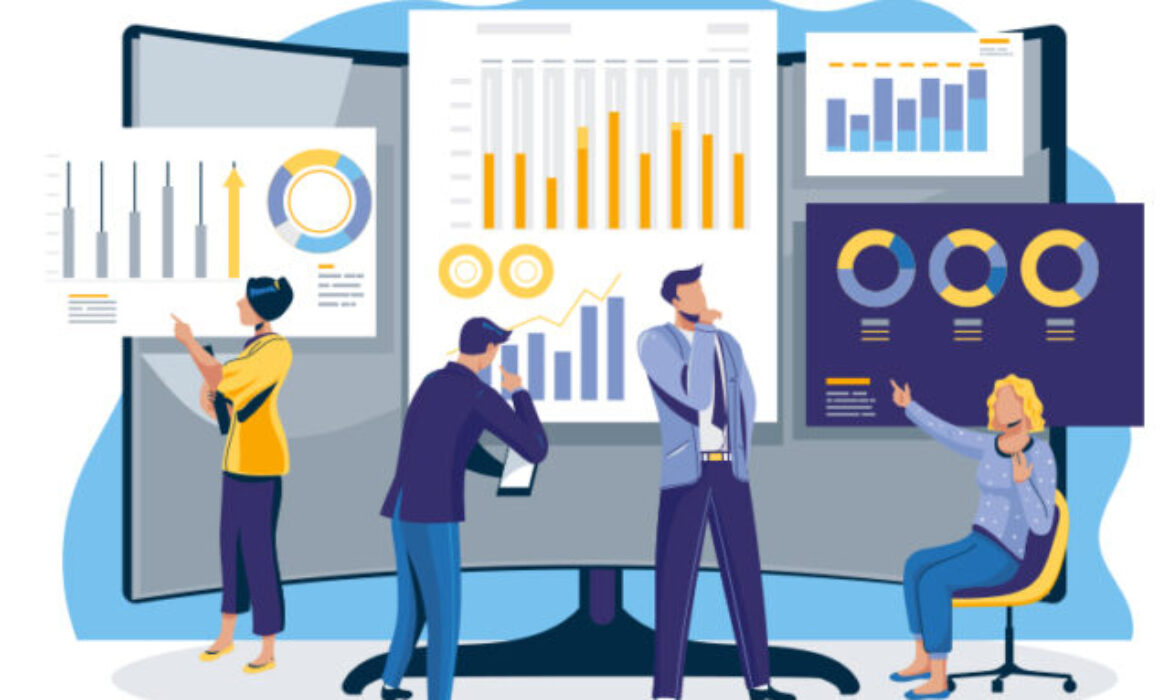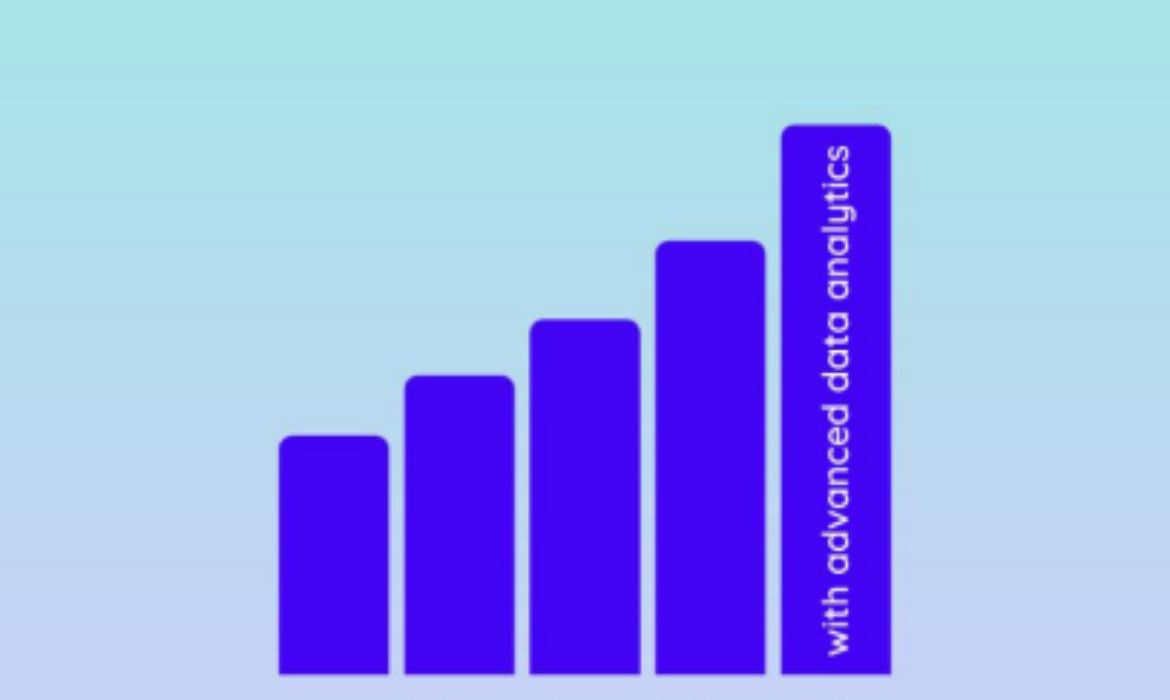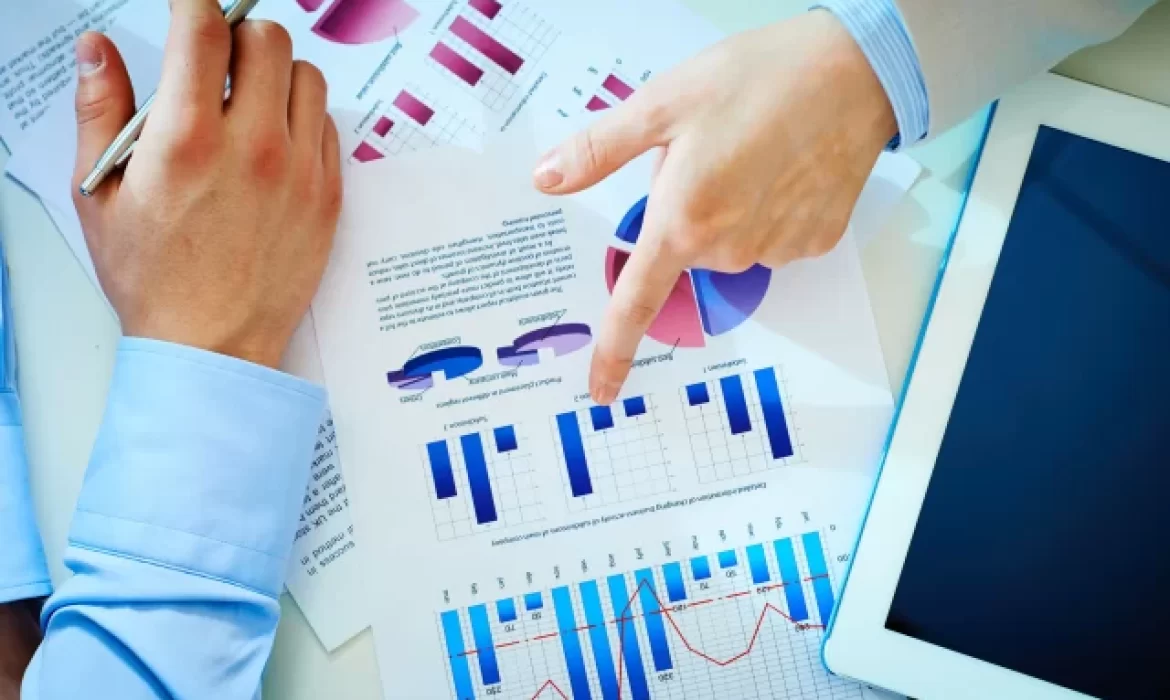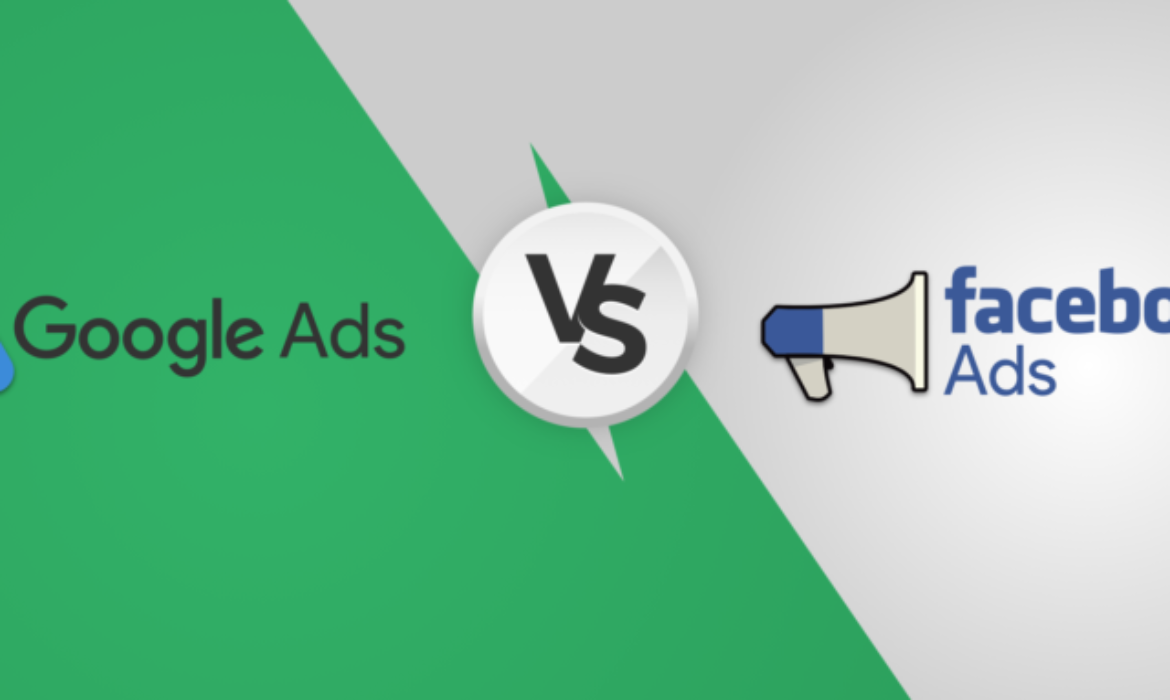What You All Need To Know About Data Visualisation? Significance & Application Area
As the world is turning to be totally data-driven, it becomes more significant than ever to have accessible modes to view and understand data. Also, the requirement for data skills in employees is increasing steadily each year. It is essential for employees, and business owners at every level must grab the understand data and its impact. Data visualization comes in handy in this scenario. To make data accessible and understandable, data visualization is the go-to tool in the form of dashboards suitable for many businesses. It helps analyze and share information.
What is Data visualization?
The graphical depiction of information and data is Data visualization. Using visual elements like charts maps, graphs, data visualization tools offer a convenient way to view and understand trends, and patterns in data. Furthermore, it supplies an excellent way for employees or business owners to offer data to non-technical viewers without confusion.
Why Is Data Visualization Important?
Data visualization offers a quick and active way to explain information using visual source. This practice is advantageous for businesses to find out
- which factors affect customer behaviour;
- identify areas required to be improved or require more attention;
- make data more notable for stakeholders;
- understand when and where to place detailed products, and foresee sales volumes.
Other Advantages of data visualization include the following:
- The competence to absorb information swiftly, recover insights to help make faster decisions;
- An increased understanding of the steps that needs to be taken to improve the organization;
- An improved ability to uphold the audience’s interest presenting the information they can understand;
- An easy distribution of information that upsurges the opportunity to share insights with everyone involved;
- Remove the need for data scientists as data is more accessible and comprehensible;
- An improved ability to act on findings fast and achieve success with incredible speed and fewer mistakes.
The world of Big Data is related to Data Visualisation. So, data visualization tools and technologies are important to analyze substantial amounts of information and make data-driven decisions simpler.
Examples Of Data Visualization:
Some visualization methods are still generally used, but more complicated techniques are now available, including the following:
- Infographics
- heat maps
- fever charts
- bubble clouds
- bullet graphs
- time-series charts
Typical Application Areas for data visualization include the following:
Sales and marketing:- Marketing teams need to pay attention to their sources of web traffic and how their web properties produce revenue. Data visualization helps it easy to see traffic trends at any time.
Scientists:- Scientific visualization, sometimes called SciVis, lets scientists and researchers to have bigger insight from their experimental data than ever before.
Finance:- It supports finance professionals analyze price movements gradually displaying important information, like stocks, securities, currencies, derivatives, bonds and commodities.
Healthcare:- Healthcare professionals nowadays use choropleth maps to picture essential health data and see how a variable, like the mortality rate of heart disease, changes across specific territories.
Logistics:- Shipping companies use this tools to determine the most practical global shipping routes.
Data scientists and researchers: – this is used by scientists typically for their own use and for presenting the information to a specific audience.
DreamITcs is the leading name in serving your company with Data Visualisation. We are dedicated to help any company while managing their strategies and perform actively by learning more about the metrics related to your company.
Harness the Power of PowerBI – Unlocking Growth Potential for Growing Businesses
In today’s fast-paced business environment, data has become a critical driver of growth and success.
As a growing business, staying competitive means being able to quickly analyze and act on the vast
amounts of data generated daily. That’s where PowerBI, a powerful business intelligence tool from
Microsoft, comes in. With its robust capabilities, PowerBI can help growing businesses make
informed decisions, optimize operations, and accelerate growth. In this article, we’ll explore how
PowerBI can revolutionize the way your growing business leverages data for success.
Improved Decision Making
One of the main challenges growing businesses face is making data-driven decisions. PowerBI offers
intuitive data visualization tools, enabling you to transform raw data into actionable insights. By
creating dynamic, interactive dashboards and reports, PowerBI helps decision-makers identify trends,
patterns, and potential issues. This real-time information allows for swift, well-informed decisions
that drive growth and improve overall business performance.
Customized Dashboards for Better Performance Tracking
Every business has unique goals and key performance indicators (KPIs). PowerBI allows for the
creation of customized dashboards tailored to your specific needs, giving you a clear and concise
view of your most relevant KPIs. As a result, you can quickly monitor performance and make
adjustments as needed, ultimately leading to more efficient operations and increased profitability.
Enhanced Collaboration and Information Sharing
Growing businesses often struggle with data silos and inefficient collaboration among team
members. PowerBI streamlines collaboration by providing a centralized platform for accessing,
analyzing, and sharing data. With its cloud-based capabilities, PowerBI allows teams to work on the
same data simultaneously and share insights effortlessly. This enhanced collaboration drives
informed decision-making and fosters a data-driven culture within your organization.
Efficient Resource Allocation
As a growing business, it’s crucial to allocate resources effectively to ensure sustainable growth.
PowerBI can help you analyze and identify areas that require more investment or optimization. By
visualizing data on expenses, revenue, and other financial metrics, PowerBI enables you to make
informed decisions about resource allocation, ultimately driving growth and ensuring long-term
success.
Read More: PowerBI Services, Advanced data visualizations Data Insights
Scalability for Future Growth
PowerBI is designed to grow with your business. As your data needs increase, PowerBI can scale to
accommodate larger datasets and more complex analytics. Its flexible architecture and compatibility
with a wide range of data sources make it a future-proof solution for your growing business.
Cost-Effective Analytics Solution
Growing businesses often have limited budgets, and investing in expensive data analytics tools can
be a challenge. PowerBI offers a cost-effective solution, with a range of subscription plans suitable for
businesses of all sizes. With its competitive pricing, PowerBI enables even small and medium-sized
businesses to harness the power of data analytics, helping them compete with larger organizations.
Seamless Integration with Existing Systems
PowerBI is built to work seamlessly with other Microsoft products and a wide range of third-party
applications, making it easy to integrate into your existing infrastructure. This compatibility allows
you to leverage the power of PowerBI without having to overhaul your entire data ecosystem, saving
you time and resources.
PowerBI is a game-changer for growing businesses looking to unlock the full potential of their data.
By offering improved decision-making, customized dashboards, enhanced collaboration, efficient
resource allocation, scalability, cost-effectiveness, and seamless integration, PowerBI empowers your
business to make data-driven decisions and accelerate growth. Start leveraging PowerBI today and
give your growing business the competitive edge it needs to succeed in the data-driven era.
——————————————————————————————————————————–
PowerBI vs. Excel – Why PowerBI is the Future of Business Analytics
Microsoft Excel has long been the go-to tool for business professionals when it comes to data
analysis and visualization. However, as technology advances and data volumes grow, the need for
more robust and sophisticated tools has become increasingly evident. Enter PowerBI: a powerful,
cloud-based business intelligence solution that offers more advanced data analytics capabilities. In
this article, we’ll explore why PowerBI is quickly outpacing Excel as the preferred tool for modern
businesses.
Data Visualization and Interactive Dashboards
While Excel is capable of creating charts and graphs, PowerBI takes data visualization to a whole new
level. With its user-friendly interface, PowerBI enables users to create visually stunning, interactive
dashboards and reports that are easy to understand and explore. Users can quickly drill down into
data, apply filters, and slice and dice information, providing a more immersive and dynamic analytics
experience compared to static Excel charts.
Handling Large Data Sets
Excel has limitations when it comes to handling large volumes of data, often slowing down or
crashing when pushed beyond its capabilities. PowerBI, on the other hand, is designed to handle big
data with ease, enabling businesses to analyze and visualize millions of rows of data quickly and
efficiently. With its built-in data compression and columnar storage, PowerBI can manage vast data
sets without sacrificing performance.
Real-Time Data and Automatic Refresh
In today’s fast-paced business environment, real-time data access is critical for informed decision making. While Excel requires manual data refreshes and updates, PowerBI offers seamless real-time
data integration and automatic refresh capabilities. By connecting directly to various data sources,
PowerBI ensures that your reports and dashboards are always up-to-date, empowering you to make
timely decisions based on the latest information.
Advanced Analytics and AI Integration
PowerBI outshines Excel when it comes to advanced analytics capabilities. With built-in features such
as trend analysis, forecasting, clustering, and integration with AI technologies like Azure Machine
Learning and Cognitive Services, PowerBI enables users to uncover deeper insights and make more
accurate predictions. These advanced capabilities help businesses stay ahead of the curve, as they
can easily identify trends and patterns that may not be immediately evident in Excel spreadsheets.
Data Security and Compliance
Data security is a top priority for businesses of all sizes, and PowerBI has the edge over Excel in this
regard. PowerBI offers enterprise-grade data security and compliance features, ensuring that your
sensitive information is protected. With role-based access control, data encryption, and detailed
auditing capabilities, PowerBI enables businesses to safeguard their data while adhering to industry specific regulations.
Read More: Harness the Power of PowerBI – Unlocking Growth Potential for Growing Businesses
Collaboration and Sharing
Collaboration and information sharing can be cumbersome in Excel, especially when working with
multiple users and large files. PowerBI simplifies the process by offering a cloud-based platform that
allows users to collaborate and share data effortlessly. With PowerBI’s sharing capabilities, teams can
work on the same data simultaneously, eliminating version control issues and ensuring a more
streamlined workflow.
Scalability and Integration
As your business grows, so do your data analysis needs. PowerBI is designed to scale with your
organization, offering flexible pricing options and seamless integration with other Microsoft products
and third-party applications. This scalability and integration enable businesses to expand their
analytics capabilities as needed, without having to invest in additional tools or overhaul existing
systems.
While Excel has been a reliable tool for basic data analysis and visualization, PowerBI is quickly
emerging as the superior solution for modern businesses. With its advanced data visualization
capabilities, ability to handle large data sets, real-time data integration, advanced analytics features,
robust data security, seamless collaboration, and scalability, PowerBI is redefining the world of
business analytics.
Read Similar Topics: What You All Need To Know About Data Visualisation? Significance & Application Area
Power BI vs. Tableau: Which Business Intelligence Tool Is Right for You?
In today’s data-driven world, businesses are constantly seeking ways to extract valuable insights from their vast amounts of data. This has led to the rise of powerful business intelligence (BI) tools that help organizations visualize and analyze data to make informed decisions.
Two popular choices in the market are Microsoft Power BI and Tableau. Both tools offer robust features and capabilities, but which one is right for you? Let’s delve into a detailed comparison to help you make an informed decision.
User Interface and Ease of Use:
When it comes to user interface, Power BI and Tableau have their unique approaches. Power BI offers a user-friendly and intuitive interface, leveraging Microsoft’s familiar design language. Its drag-and-drop functionality and pre-built templates make it easy for beginners to get started quickly. On the other hand, Tableau provides a more flexible and visually appealing interface that allows users to create highly customized dashboards and reports. However, Tableau’s learning curve can be steeper for novices.
Data Connectivity and Integration:
Both Power BI and Tableau offer extensive data connectivity options. Power BI seamlessly integrates with other Microsoft products, such as Excel and Azure, making it an ideal choice for organizations heavily invested in the Microsoft ecosystem. It also supports a wide range of data sources, including on-premises databases, cloud services, and popular third-party applications. Tableau, on the other hand, provides connectors for various data sources, including spreadsheets, databases, and cloud platforms, ensuring compatibility with diverse environments.
Visualization and Analytics Capabilities:
Tableau has long been praised for its exceptional data visualization capabilities. Its vast array of chart types, color schemes, and interactive features enable users to create stunning visual representations of data. Tableau’s drag-and-drop interface allows for effortless exploration and analysis. Power BI, however, has made significant strides in this area and now offers a rich set of visualizations and interactive features. It also benefits from tight integration with Microsoft Excel and other Office products, enabling users to leverage Excel’s powerful data manipulation capabilities.
Pricing and Scalability:
Pricing is a crucial factor when selecting a BI tool. Power BI offers a range of pricing options, including a free version with limited features, making it an attractive choice for small businesses and individuals. Its paid plans offer more advanced functionalities and are priced competitively. Tableau, on the other hand, is generally considered more expensive. While it offers a free version, its premium plans can be cost-prohibitive for smaller organizations. However, Tableau’s scalability and robust enterprise-level features make it a preferred choice for larger corporations.
Community and Support:
The availability of a thriving community and robust support resources is essential for any BI tool. Power BI benefits from Microsoft’s extensive user base, active online forums, and comprehensive documentation. It also offers regular updates and enhancements based on user feedback. Tableau has a vibrant community as well, with dedicated user groups and forums. Additionally, Tableau provides comprehensive training programs and certifications, which can be beneficial for professionals looking to enhance their skills.
In conclusion, both Power BI and Tableau are powerful BI tools with their unique strengths. Power BI excels in its seamless integration with Microsoft products, ease of use, and competitive pricing. Tableau, on the other hand, offers unmatched data visualization capabilities, flexibility, and scalability. Ultimately, the choice between the two depends on your specific requirements, budget, and existing technology stack. It’s recommended to evaluate your needs thoroughly, consider the strengths of each tool, and even try out their free versions or demos before making a decision.
Also Read, PowerBI vs. Excel – Why PowerBI is the Future of Business Analytics
Unveiling the Biggest PPC Trends in 2023: Revolutionizing Digital Advertising
In the rapidly evolving world of digital advertising, staying up-to-date with the latest trends is crucial for businesses aiming to maximize their online visibility and drive conversions. Pay-per-click (PPC) advertising, in particular, has been a dominant force in the digital marketing landscape, offering unparalleled targeting capabilities and measurable results. As we dive into 2023, a new wave of PPC trends is set to reshape the way businesses engage with their audience and achieve advertising success. Let’s explore the biggest PPC trends that will take center stage this year.
Enhanced Audience Targeting: In 2023, PPC advertising will become increasingly focused on reaching the right audience at the right time. Ad platforms are investing heavily in refining audience targeting capabilities, leveraging advanced algorithms and machine learning to analyze user data. Expect to see more precise targeting options based on demographics, interests, behaviors, and even real-time intent signals, allowing businesses to reach highly relevant audiences with their PPC campaigns.
Rise of Voice Search Advertising: With the growing popularity of voice-enabled devices and virtual assistants, voice search is quickly becoming an integral part of our daily lives. As a result, PPC advertisers are adapting to this shift by optimizing their campaigns for voice search. Long-tail keywords and conversational phrases will gain prominence, as advertisers strive to align their ad copy with the way people speak and search through voice commands.
Video Ads Domination: Video content has already proven to be a powerful medium for engaging audiences, and in 2023, video ads will take center stage in PPC advertising. Platforms like YouTube and Facebook have expanded their video ad offerings, providing advertisers with more creative formats and targeting options. The ability to convey messages visually and emotionally through video will be a key driver in capturing users’ attention and driving conversions.
Mobile-First Approach: Mobile devices continue to dominate the digital landscape, and advertisers must prioritize a mobile-first approach in their PPC strategies. Mobile-optimized ad formats, such as responsive search ads and accelerated mobile pages (AMP), will become the norm. Advertisers will also focus on enhancing mobile landing page experiences to ensure seamless user journeys and maximize conversions.
AI-Powered Automation: Artificial intelligence (AI) is revolutionizing PPC advertising by enabling sophisticated automation and optimization. In 2023, AI-powered tools will play a significant role in managing PPC campaigns more efficiently. From automated bid adjustments and ad scheduling to dynamic ad creation and performance tracking, AI will streamline campaign management, freeing up marketers’ time for strategic decision-making.
Privacy and Data Protection: Data privacy concerns and increasing regulations have prompted major changes in the digital advertising landscape. Advertisers must adapt to a new era of privacy-conscious consumers. Privacy-focused PPC trends will include increased emphasis on first-party data, consent-based targeting, and compliance with stricter data protection regulations. Building trust and transparency with users will be essential for successful PPC campaigns.
Smart Bidding Strategies: Bidding strategies are evolving, with a shift towards more intelligent and automated approaches. Smart bidding algorithms, powered by machine learning, will optimize bids based on various factors, such as conversion probability and value. Advertisers will rely on automated bidding strategies like target CPA (cost per acquisition) and target ROAS (return on ad spend) to maximize campaign performance and ROI.
As 2023 unfolds, businesses must stay agile and adapt to these PPC trends to remain competitive in the digital advertising landscape. Embracing enhanced audience targeting, optimizing for voice search, leveraging video ads, adopting a mobile-first approach, harnessing AI-powered automation, prioritizing privacy and data protection, and embracing smart bidding strategies will be crucial for driving successful PPC campaigns in the coming year.
Google Ads or Facebook Ads: Which Pay-Per-Click Company Should You Invest In?
In today’s digital landscape, pay-per-click (PPC) advertising has become a vital tool for businesses to reach their target audience effectively. Two major players in this arena are Google Ads and Facebook Ads. Both platforms offer unique advantages and cater to different marketing objectives. In this article, we will delve into the pros and cons of investing in Google Ads and Facebook Ads, helping you make an informed decision on where to allocate your advertising budget.
Google Ads: Dominating Search Advertising
When it comes to search engine marketing, Google Ads stands tall as the undisputed leader. Google processes over 3.5 billion searches per day, giving advertisers unparalleled access to a vast audience actively seeking information, products, and services. With Google Ads, you can bid on relevant keywords and have your ads displayed prominently on search engine result pages (SERPs).
The primary advantage of Google Ads lies in its intent-based targeting. Users are actively searching for specific keywords, which allows you to display highly relevant ads that capture their attention at the right moment. Furthermore, Google’s extensive ad network enables your ads to reach users across various websites, mobile apps, and partner platforms.
Facebook Ads: Targeting Based on User Interests
Facebook, with its massive user base exceeding 2.85 billion, presents an entirely different advertising landscape. Facebook Ads focus on reaching users based on their interests, demographics, and online behavior. The platform collects vast amounts of user data, allowing businesses to create highly targeted and personalized campaigns.
One of the key strengths of Facebook Ads is its advanced targeting options. Advertisers can narrow down their audience based on age, gender, location, interests, and even specific behaviors. This level of granularity enables businesses to reach niche markets and deliver tailored messages to their ideal customers.
Comparing Google Ads and Facebook Ads:
Search Intent vs. Passive Engagement: Google Ads leverage the power of search intent, ensuring that your ads are shown to users actively searching for relevant keywords. This makes it particularly effective for businesses that rely on direct conversions and high-intent leads. Conversely, Facebook Ads excel in generating awareness and engagement, as users are often in a more passive browsing mindset.
Cost and Competition: The cost per click (CPC) on Google Ads tends to be higher due to intense competition, especially for popular keywords. On the other hand, Facebook Ads offer relatively lower CPC rates, making it an attractive option for businesses on a tight budget.
Ad Formats and Creatives: Google Ads primarily focus on text-based ads, although it also offers display ads and video ads. Facebook Ads, on the other hand, offers a wider range of ad formats, including image ads, video ads, carousel ads, and more. The visually appealing nature of Facebook Ads allows for more creative and immersive storytelling.
Audience Reach and Targeting: Google Ads, with its extensive search network, ensures broad audience reach, making it ideal for businesses targeting a wide market. Conversely, Facebook Ads enable granular targeting and reach niche audiences based on specific demographics, interests, and behaviors.
Conclusion:
Deciding whether to invest in Google Ads or Facebook Ads depends on your business objectives, target audience, and marketing budget. Google Ads excels in capturing high-intent leads and driving direct conversions, making it a preferred choice for businesses focused on immediate results. On the other hand, Facebook Ads provide unparalleled targeting options and are suitable for businesses seeking to build brand awareness and engage with a specific audience.
Ultimately, the best approach might involve leveraging both platforms in a well-rounded digital marketing strategy. By combining the intent-based targeting of Google Ads with the precise audience targeting of Facebook Ads, businesses can maximize their reach and conversions.
Regardless of your choice, it’s essential to carefully analyze your campaign metrics, track conversions, and continually optimize your ads to ensure a strong return on investment. Regular monitoring and adjustments based on performance data will help you refine your PPC strategy and drive the best results for your business.








